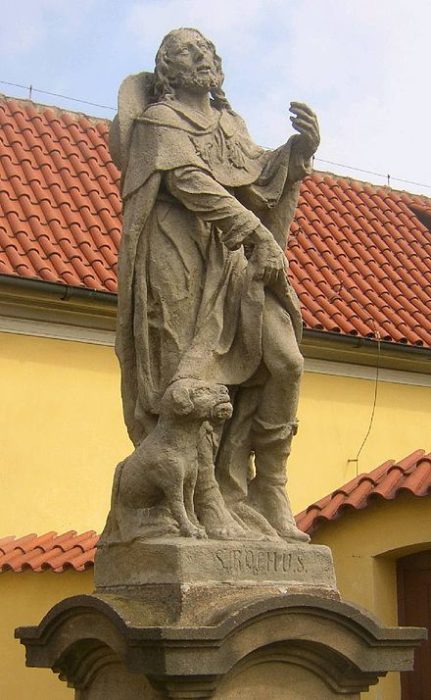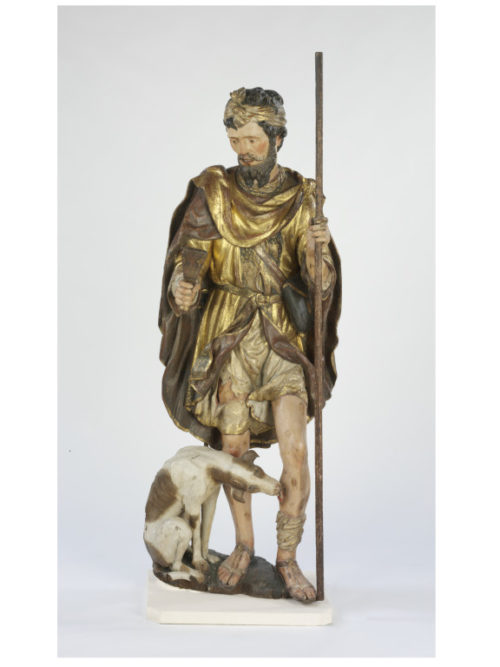St Roch, Patron Saint of Dogs

St Roch in Prague, 1751
This is in honor St. Roch (also spelled Rocco, Roque, and even Rocky), the patron saint of dogs. He’s also the patron saint of those who are falsely accused, as he was. Most important, he’s a miraculous healer invoked to protect people against illness, who became especially important during the terrible plague years. In 1414, prayers and processions offered in his name were believed to have stopped the plague from spreading through a city. Churches all over the country and the world (maybe you’ve attended one) are named for him. His main feast day falls on August 16th, but this site wasn’t up yet—so I’m posting this for his second feast day, September 9th.
Saints bring us a little closer to God. In their stories, a human story turns into a holy one. While saints’ lives are full of suffering, betrayal, and tragedy, saints remain steadfast and offer consolation and hope. They were ordinary people once, and ordinary people can call on them for help ever after.
My perspective on saints is decidedly secular but deeply appreciative. I love their grassroots energy. They come into being when and where we need them most. They express human needs—spiritual and physical, universal and personal—and there are saints for nearly everyone and everything. What’s more, many of their stories include animals, both wild and domestic.
As saints proliferated, popular spiritual energy collided with the Church’s need to control the story. Saints’ cults were local first, and as their stories spread and gained power, the Church had to catch up with the people.This is true of St Roch. He was honored as a saint long before the Pope recognized him.
Not surprisingly, since his story is 700 years old, there are many versions of St Roch’s life. Here’s an outline of his story.
Born in the late 13thcentury, he was the son of the governor of Montpellier. When he was 20, he lost both parents. As his father lay on his deathbed, he named his son to succeed him as governor, but the pious young man gave up power and gave away his wealth and set out for Rome as a mendicant pilgrim, which meant that he depended on the kindness of others to survive. He arrived in Italy during an epidemic and left off his pilgrimage to devote himself to caring for the sick. He became renowned for curing people through the power of faith and prayer.
Eventually, however, he caught the plague too, was exiled from the town, and retreated to a rough shelter in a forest. Then, as in so many stories of heroes, he received supernatural help. A spring bubbled up to supply him with water, and a dog brought him food and licked his wounds until they healed. (The Catholic Encyclopedia I checked makes no mention of the spring or the dog, but credits a person with finding and saving him.)

St Roch, Victoria and Albert Museum
The story then takes him back to Montpellier, but he disguised himself since he still wanted no worldly fame, power, or wealth. His uncle, who had become governor in his absence, feared that the newcomer was a spy and had him jailed. After five years, St Roch died in prison. After his death, a distinctive birthmark on his chest, the sign of a cross, revealed who he really was—and a church was built in his honor. After that, he swiftly became a saint.
Although St Roch died before the Black Death struck Europe and wasn’t recognized by the Church until the late 16thcentury, he was widely revered for protecting people against the plague. He was there when people needed him most.
For me, he’s a tender figure. He suffered and came close to death, but was miraculously saved—as he had saved others who were close to death. Paintings and statues of St Roch almost all show him standing and pointing to a bubo, a symptom of the plague, on his leg and accompanied by the dog who saved his life, which often holds a loaf of bread in its mouth. In one lovely 16th-century statue from Spain the dog licks his wounds.
What about the dog? He’s a classic figure straight out of myth and folklore certainly, the loyal hound or animal helper who miraculously appears and rescues the hero in crisis. Then the dog disappears—but continues to be honored in St Roch’s story for the generous part it played.
